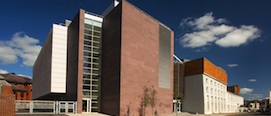2013 Press Releases
Stand tall and keep cool

The development has implications for the energy efficiency of common consumer electronics, such as laptops and mobile phones, as well as increased tissue repair in the body through electrical stimulation.
By finding out how molecules behave in electrical devices, a ten-fold increase in switching efficiency was obtained by changing just one carbon atom. The science behind the breakthrough will be documented in the February issue of Nature Nanotechnology.
Dr. Damien Thompson, Tyndall National Institute, UCC and a team of researchers at the National University of Singapore, led by Professor Chris Nijhuis, designed and created the devices, which are based on molecules acting as electrical valves, or diode rectifiers.
Dr. Thompson explains: "These molecules are very useful because they allow current to flow through them when switched on and block current flow when switched off. The results of the study show that simply adding one extra carbon is sufficient to improve the device performance by more than a factor of ten. We are following up lots of new ideas based on these results, and we hope ultimately to create a range of new components for electronic devices."
Dr. Thompson's atom-level computer simulations showed how molecules with an odd number of carbon atoms stand straighter than molecules with an even number of carbon atoms. This allows them to pack together more closely. Tightly packed assemblies of these molecules were formed on metal electrode surfaces by the Nijhuis group in Singapore and were found to be remarkably free of defects. These high-quality devices can suppress leakage currents and so operate more efficiently and reliably. The device can be cleanly switched on and off purely on the basis of the charge and shape of the molecules, just like in the biological nanomachines that regulate photosynthesis, cell division and tissue growth.
Tyndall Electronic Theory Group leader Professor Jim Greer comments: "Modern electronic devices such as telephones and tablets in manufacture today rely on tiny switches approaching molecular sizes. This provides new challenges for electronics, but also opens up exciting opportunities for blending molecular properties to be used to our advantage.”
This research, which was in part funded by a Science Foundation Ireland Starting Investigator award to Dr. Thompson, represents a key advance towards the creation of technologically viable ultra-small device components. The computer simulations were performed on Science Foundation Ireland-supported computing clusters at Tyndall and at the Irish Centre for High-End Computing. The combined experiments and simulations show for the first time that minute improvements in molecule orientation and packing trigger changes in van der Waals forces that are sufficiently large to dramatically improve the performance of electronic devices.
For an advance peek at the February issue of Nature Nanotechnology, see doi:10.1038/nnano.2012.238
